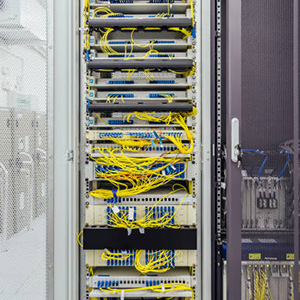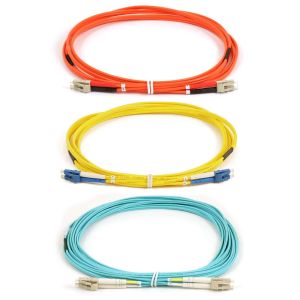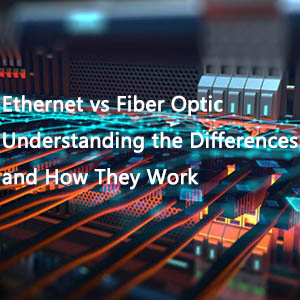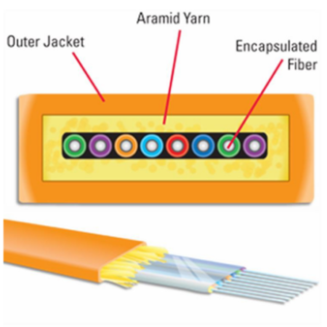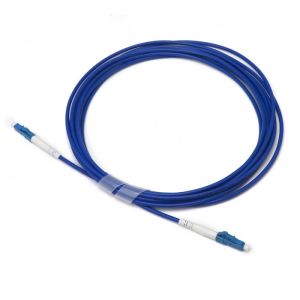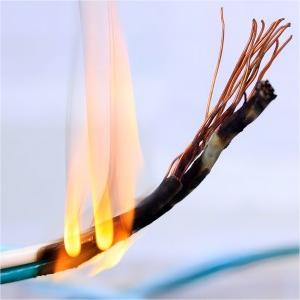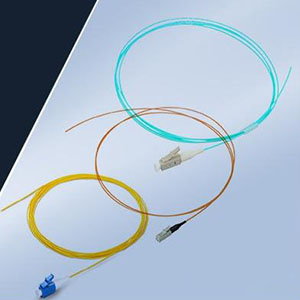When designing efficient and scalable data centers, network designers are faced with the challenge of managing huge fiber requirements in limited physical space while reducing cable congestion. For example, MTP®/MPO cable (i.e. multi-channel pluggable) cabling solutions have become a trend, which not only increases cabling density, but also enables rapid deployment and maintenance of multiple fiber connections through a single plug-in operation. This solution is critical to solving data centers with limited space and requiring a large number of fiber connections.
What Are MTP®/MPO Cables?
MPO (Multi-Fiber Push-on) is the first generation of clip clamping multi-core optical fiber connectors. MTP® is a registered trademark of US Conec Ltd., which is an advanced version of MPO, with better mechanical and optical performance. They look alike and are completely compatible and interminable. And there are four MTP®/MPO cable types: MTP®/MPO Jumper Cables, MTP®/MPO Trunk Cables, MTP®/MPO Harness Cables, and MTP®/MPO Conversion Cables.
MTP®/MPO cables, which consist of MTP®/MPO connectors and optical fibers, are essential components for high-density connectivity solutions. These connectors are available in two types: female (without pins) and male (with pins). By significantly increasing cable density and saving valuable circuit card and rack space, MTP®/MPO connectors are ideally suited for current 40G/100G cabling systems and future network speed upgrades. For a more in-depth understanding of MTP® connectors, their benefits, and application scenarios, you can refer to this comprehensive guide: A Comprehensive Guide to MTP® Connector.

MTP®/MPO Connector Structure.
Applications of MTP®/MPO Cable Types in 5 Performances
MTP®/MPO cable types are dominated by 5 performances, including function, polarity, fiber count, fiber mode, and jacket rating. Various MTP®/MPO cables are available for different application environments and requirements.
By Function
Four MTP®/MPO cable types, such as jumper cables, trunk cables, MTP®/MPO harness cables, and MTP®/MPO conversion cables, are well suited for high-density cabling networks, providing better network capacity and flexibility.
MTP®/MPO Jumper Cables
MTP®/MPO jumper cables are terminated with an MTP®/MPO connector (female/male) on both ends, which are available in 8-144 fiber counts for users’ choices. Typically, these multi-fiber MTP®/MPO jumper fibers use a single-sheath design and are ideal for connecting different pieces of equipment within a cabinet, such as from a fiber patch panel to a switch or from one switch to another.

MTP®/MPO Jumper Cable Connects Two 100G Transceivers.
MTP®/MPO Trunk Cables
MTP®/MPO trunk cables usually have high fiber counts and adopt a double-sheathed design, which has stronger tensile and compressive resistance, especially suitable for interconnection between cabinets and connections in different areas of buildings. The double-sheathed standard provides greater compression and stability for the fiber, ensuring it can withstand greater pressure on the bridge and greater tensile force during construction. The following link core and access layer connections are in different areas, and here we use the MTP®/MPO-12 trunk cable to achieve the 40G link.

MTP®/MPO Trunk Cable Connects the Core and Access Layers
MTP®/MPO Harness Cables
MTP®/MPO harness cables (aka. breakout cables or fanout cables) are terminated with a female/male MTP®/MPO connector on one end and 4/6/8/12 duplex LC/FC/SC/ST connectors on the other end, such as 8-fiber MTP®/MPO to 4 LC harness cables and 12-fiber MTP®/MPO to 6 LC harness cables. Typically, these breakout cables are ideal for short-range 10G–40G and 25G–100G direct connections or for connecting backbone assemblies to a rack system in high-density backbone cabling.

25G-100G Direct Connection with MTP®/MPO Harness Cable.
MTP®/MPO Conversion Cables
Fiber-Life supply MTP Trunk Cables
MTP®/MPO conversion cables have the same fanout design as MTP®/MPO breakout cables but differ in fiber counts and types. Specifically, commonly used ones are 24-fiber to 2×12-fiber, 24-fiber to 3×8-fiber, 16-fiber to 2×8-fiber, 12-fiber to 2×4-fiber, and 2×12-fiber to 3×8-fiber MTP®/MPO conversion cables.They are especially ideal for 10G-40G, 40G-40G, 40G-100G, and 40G-120G connections, which eliminate fiber wasting and largely increase the flexibility of MTP®/MPO cabling systems.
40G-120G Direct Connection with MTP®/MPO Conversion Cable.
By Polarity
MTP®/MPO cable types by polarity refer to the difference between the optical transmitters and receivers at both ends of the fiber link. Due to the special design of MTP®/MPO connectors, polarity issues must be addressed in high-density MTP®/MPO cabling systems.
The TIA 568 standard defines three connection methods to ensure the correct polarity of the optical path, called Type A, Type B, and Type C. The cables of the three MTP®/MPO connector types have different structures. Read the white paper Understanding MTP®/MPO Cable Polarity for more information about common 8/12/24-fiber MTP®/MPO cable polarity and connectivity methods. And now, ANSI/TIA-568.3-E introduced two new universal polarity methods: U1 and U2, which can streamline fiber cabling installations and maintenance.

12-Fiber MTP®/MPO Cable Polarity.
By Fiber Count
MTP®/MPO cable types with different cores are classified into 8/12/24 cores, usually used for 40G/100G. The latest 16-fiber cables are especially designed for short-reach 400G cabling in hyperscale data centers.
- 8-fiber MTP®/MPO cable systems can transmit the same data rates as 12-fiber cables with lower cost and insertion loss, making them more cost-effective.
- 12-fiber MTP®/MPO cables are the earliest developed and most commonly used solution in 10G–40G and 40G–100G connections. If they are used in 40G QSFP+ or 100G QSFP28 transceivers, 4 fibers will be idle, resulting in low fiber utilization.
- 24-fiber MTP®/MPO cables are typically used to establish a 100GBASE-SR10 link between CFP-to-CFP transceivers.
- 16-fiber MTP®/MPO cables use the same external footprint as traditional 12-fiber MT (mechanically transferable) ferrules, aggregate multiple 8-fiber parallel transceivers, and couple directly to emerging 16-fiber parallel fiber links such as 400G QSFP-DD and OSFP.
By Fiber Mode
According to Fiber Mode, MTP®/MPO cable types include multimode OM3/OM4/OM5 and single-mode OS2 cables. Multimode OM3/OM4/OM5 MTP®/MPO cables are suitable for short distance transmission, allowing 40 Git/s maximum transmission distance of 300m/400m/440m respectively(with corresponding module). Single-mode OS2 MTP®/MPO cables are suitable for long-distance transmission, such as in Metropolitan Area Networks (MANs) and PONs (Passive Optical Networks). With less modal dispersion, the bandwidth of OS2 is higher than OM3/OM4/OM5. The maximum transmission distance that can be achieved by MTP cables is listed below. Please note that it needs to be used with the corresponding module to achieve the maximum distance transmission. For example, a single-mode mtp-12 trunk needs to be used with a 40G QSFP-PLR4-40G module to achieve 10km transmission.
By Jacket Rating
According to different fire rating requirements, the jackets of MTP®/MPO cable types are classified as LSZH (Low Smoke Zero Halogen), OFNP (Optical Fiber Nonconductive, Plenum), OFNR (Optical Fiber Nonconductive, Riser), etc.
- LSZH MTP®/MPO cables are free of halogenated materials (toxic and corrosive during combustion), which can better protect personnel and equipment during fires and are suitable for closed places.
- OFNP MTP®/MPO cables contain no electrically conductive elements and are designed with the highest fire rating, which can be installed in ducts, plenums, and other spaces for building airflow.
- OFNR MTP®/MPO cables are non-conductive, flame-retardant cables suitable for vertical shafts between floors and other indoor environments, meeting high fire protection standards. However, it is worth noting that OFNR cables cannot be used in ventilated areas.


